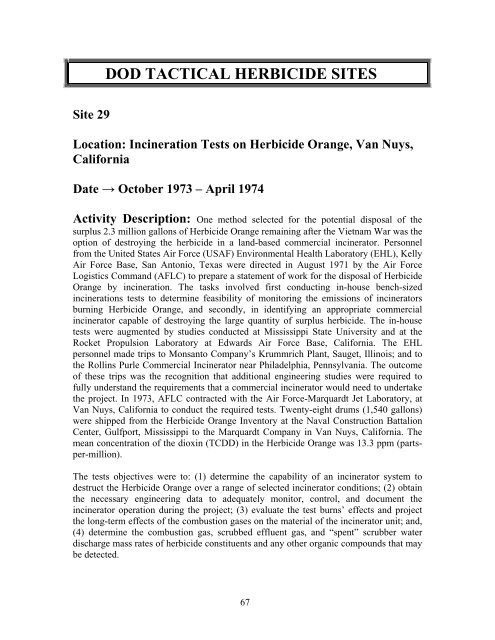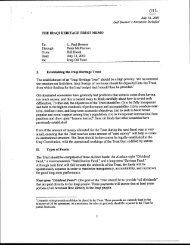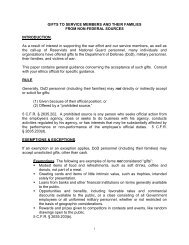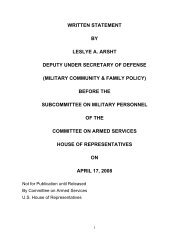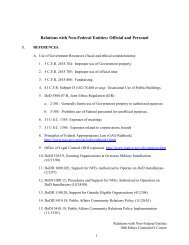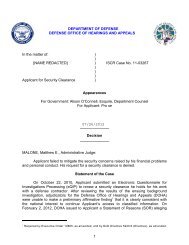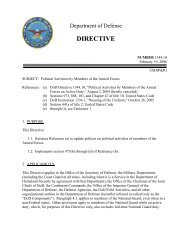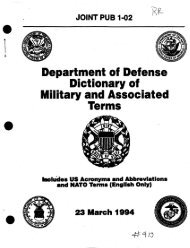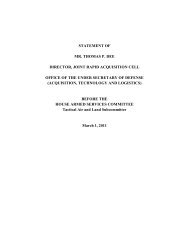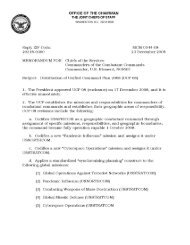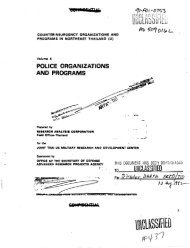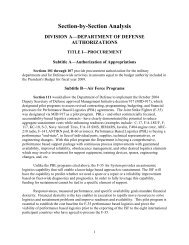dod tactical herbicide sites - United States Department of Defense
dod tactical herbicide sites - United States Department of Defense
dod tactical herbicide sites - United States Department of Defense
You also want an ePaper? Increase the reach of your titles
YUMPU automatically turns print PDFs into web optimized ePapers that Google loves.
DOD TACTICAL HERBICIDE SITESSite 29Location: Incineration Tests on Herbicide Orange, Van Nuys,CaliforniaDate → October 1973 – April 1974Activity Description: One method selected for the potential disposal <strong>of</strong> thesurplus 2.3 million gallons <strong>of</strong> Herbicide Orange remaining after the Vietnam War was theoption <strong>of</strong> destroying the <strong>herbicide</strong> in a land-based commercial incinerator. Personnelfrom the <strong>United</strong> <strong>States</strong> Air Force (USAF) Environmental Health Laboratory (EHL), KellyAir Force Base, San Antonio, Texas were directed in August 1971 by the Air ForceLogistics Command (AFLC) to prepare a statement <strong>of</strong> work for the disposal <strong>of</strong> HerbicideOrange by incineration. The tasks involved first conducting in-house bench-sizedincinerations tests to determine feasibility <strong>of</strong> monitoring the emissions <strong>of</strong> incineratorsburning Herbicide Orange, and secondly, in identifying an appropriate commercialincinerator capable <strong>of</strong> destroying the large quantity <strong>of</strong> surplus <strong>herbicide</strong>. The in-housetests were augmented by studies conducted at Mississippi State University and at theRocket Propulsion Laboratory at Edwards Air Force Base, California. The EHLpersonnel made trips to Monsanto Company’s Krummrich Plant, Sauget, Illinois; and tothe Rollins Purle Commercial Incinerator near Philadelphia, Pennsylvania. The outcome<strong>of</strong> these trips was the recognition that additional engineering studies were required t<strong>of</strong>ully understand the requirements that a commercial incinerator would need to undertakethe project. In 1973, AFLC contracted with the Air Force-Marquardt Jet Laboratory, atVan Nuys, California to conduct the required tests. Twenty-eight drums (1,540 gallons)were shipped from the Herbicide Orange Inventory at the Naval Construction BattalionCenter, Gulfport, Mississippi to the Marquardt Company in Van Nuys, California. Themean concentration <strong>of</strong> the dioxin (TCDD) in the Herbicide Orange was 13.3 ppm (partsper-million).The tests objectives were to: (1) determine the capability <strong>of</strong> an incinerator system todestruct the Herbicide Orange over a range <strong>of</strong> selected incinerator conditions; (2) obtainthe necessary engineering data to adequately monitor, control, and document theincinerator operation during the project; (3) evaluate the test burns’ effects and projectthe long-term effects <strong>of</strong> the combustion gases on the material <strong>of</strong> the incinerator unit; and,(4) determine the combustion gas, scrubbed effluent gas, and “spent” scrubber waterdischarge mass rates <strong>of</strong> <strong>herbicide</strong> constituents and any other organic compounds that maybe detected.67


